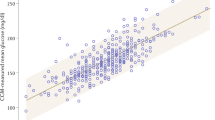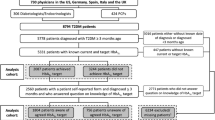Abstract
Current guidelines specify hemoglobin A1c (HbA1c) targets around or less than 7.0 %, with more (<6.5 %) or less (<8 %) stringent goals being appropriate for selected patients. The difficulty in setting a precise HbA1c target depends, at least in part, on the physician perception of the relative importance of the parameters to be considered when determining the target. Using the “a priori” approach, physicians set the HbA1c target first, then prescribe the appropriate antidiabetic drug in order to cover the distance from the target, i.e., the difference between the current HbA1c value of the patient and the individualized HbA1c target: calculating the distance from the target may also be useful as a predictor of therapeutic success. In the “a posteriori” approach, physicians first prescribe, then decide if the achieved HbA1c is an appropriate level for that patient. Attainment of the HbA1c target ultimately depends on which target the physician set: both approaches (“a priori” and “a posteriori”) may be useful for both physicians to make appropriate therapeutic decisions and patients to adhere to the best possible treatment. All this presumably will avoid unnecessary therapeutic inertia.
Similar content being viewed by others
References
Standards of Medical Care in Diabetes-2014, Diabetes Care 37(Supplement 1), S14–S80 (2014)
F. Ismail-Beigi, E. Moghissi, M. Tiktin, I.B. Hirsch, S.E. Inzucchi, S. Genuth, Individualizing glycemic targets in type 2 diabetes mellitus: implications of recent clinical trials. Ann. Intern. Med. 154, 554–559 (2011)
S.E. Inzucchi, R.M. Bergenstal, J.B. Buse, M. Diamant, E. Ferrannini, M. Nauck, A.L. Peters, A. Tsapas, R. Wender, D.R. Matthews, Management of hyperglycemia in type 2 diabetes, 2015: a patient-centered approach. Update to a position statement of the American Diabetes Association and the European Association for the Study of Diabetes. Diabetes Care 38, 140–149 (2015)
K. Esposito, M.I. Maiorino, G. Bellastella, D. Giugliano, New guidelines for metabolic targets in diabetes: clinician’s opinion does matter. Endocrine 46, 431–434 (2014)
A.B. Evert, J.L. Boucher, M. Cypress, S.A. Dunbar, M.J. Franz, E.J. Mayer-Davis, J.J. Neumiller, R. Nwankwo, C.L. Verdi, P. Urbanski, W.S. Yancy Jr, Nutrition therapy recommendations for the management of adults with diabetes. Diabetes Care 37(Supplement 1), S120–S143 (2014)
The Emerging Risk Factors Collaboration, S.R. Seshasai, S. Kaptoge, A. Thompson, E. Di Angelantonio, P. Gao, N. Sarwar et al., Diabetes mellitus, fasting glucose, and risk of cause-specific death. N. Engl. J. Med. 364, 829–841 (2011)
The World Factbook—CIA. United States, People and Society, Life Expectancy. (https://www.cia.gov/library/publications/the-world-factbook/geos/us.html). Last Accessed 7 Nov 2014
The American College of Cardiology and the American Heart Association. 2013 Prevention Guidelines ASCVD Risk Estimator. http://static.heart.org/ahamah/risk/Omnibus_Risk_Estimator.xls. Last Accessed 7 Nov 2014
A. Tversky, D. Kahneman, Judgment under uncertainty: heuristics and biases. Science 185, 1124–1131 (1974)
AMD. Personalization of therapy in type 2 diabetes. English version—last updated and revised: May 2013 (http://www.aemmedi.it/algoritmi_en_2013/algoritmi.html). Last Accessed 7 Nov 2014
Canadian Diabetes Association. Clinical Practice Guidelines. (http://guidelines.diabetes.ca/bloodglucoselowering/a1ctarget). Last Accessed 7 Nov 2014
I. Raz, M.C. Riddle, J. Rosenstock, J.B. Buse, S.E. Inzucchi, P.D. Home, Personalized management of hyperglycemia in type 2 diabetes. Reflections from a Diabetes Care Editors’ Expert Forum. Diabetes Care 36, 1779–1788 (2013)
O.J. Phung, J.M. Scholle, M. Talwar, G.I. Coleman, Effect of noninsulin antidiabetic drugs added to metformin therapy on glycemic control, weight gain, and hypoglycemia in type 2 diabetes. JAMA 303, 1410–1418 (2010)
J.L. Gros, C.K. Kramer, C.B. Leitão, N. Hawkins, L.V. Viana, B.D. Schaan, L.C. Pinto, T.C. Rodrigues, M.J. Azevedo, For the Diabetes and Endocrinology Meta-analysis Group (DEMA), Effect of antihyperglycemic agents added to metformin and a sulfonylurea on glycemic control and weight gain in type 2 diabetes: a network meta-analysis. Ann. Intern. Med. 154, 672–679 (2011)
K. Esposito, P. Chiodini, G. Bellastella, M.I. Maiorino, D. Giugliano, Proportion of patients at HbA1c target <7% with eight classes of antidiabetic drugs in type 2 diabetes: systematic review of 218 randomized controlled trials with 78 945 patients. Diabetes Obes. Metab. 14, 228–233 (2012)
C.L. Morgan, C.D. Poole, M. Evans, A.H. Barnett, S. Jenkins-Jones, C.J. Currie, What next after metformin? A retrospective evaluation of the outcome of second-line, glucose-lowering therapies in people with type 2 diabetes. J. Clin. Endocrinol. Metab. 97, 4605–4612 (2012)
P.M. Rothwell, External validity of randomised controlled trials: “To whom do the results of this trial apply?”. Lancet 365, 82–93 (2005)
W. Summerskill, Evidence-based practice and the individual. Lancet. 365, 13–14 (2005)
B. Ahrén, C. Mathieu, G. Bader, A. Schweizer, J.E. Foley, Efficacy of vildagliptin versus sulfonylureas as add-on therapy to metformin: comparison of results from randomised controlled and observational studies. Diabetologia 57, 1304–1307 (2014)
P.D. Home, C. Shen, M.I. Hasan, Z.A. Latif, J.-W. Chen, G. Gonzalez, Gàlvez, Predictive and explanatory factors of change in HbA1c in a 24-week observational study of 66,726 people with type 2 diabetes starting insulin analogs. Diabetes Care 37, 1237–1245 (2014)
J.B. Brown, G.A. Nichols, A. Perry, The burden of treatment failure in type 2 diabetes. Diabetes Care 27, 1535–1540 (2004)
M.J. Calvert, R.J. McManus, N. Freemantle, Management of type 2 diabetes with multiple oral hypoglycaemic agents or insulin in primary care: retrospective cohort study. Br. J. Gen. Pract. 57, 455–460 (2007)
K. Khunti, M.L. Wolden, B.L. Thorsted, M. Andersen, M.J. Davies, Clinical inertia in people with type 2 diabetes: a retrospective cohort study of more than 80,000 people. Diabetes Care 36, 3411–3417 (2013)
D. Giugliano, K. Esposito, Clinical inertia as a clinical safeguard. JAMA 305, 1591–1592 (2011)
R.R. Holman, S.K. Paul, M.A. Bethel, D.R. Matthews, N.A. Neil, 10-year follow up of intensive glucose control in type 2 diabetes. N. Engl. J. Med. 359, 1577–1589 (2008)
K. J. Lipska, J. S. Ross, Y. Miao, N. D. Shah, S. J. Lee, M. A. Steinman, Overtreatment of diabetes mellitus in older adults with tight glycemic control. JAMA Intern Med. doi:10.1001/jamainternmed.2014.7345. Published online January 12, 2015
T. Higgins, HbA1c for screening and diagnosis of diabetes mellitus. Endocrine 43, 266–273 (2013)
Conflict of interest
The authors declare no conflict of interest.
Author information
Authors and Affiliations
Corresponding author
Rights and permissions
About this article
Cite this article
Giugliano, D., Maiorino, M.I., Bellastella, G. et al. Setting the hemoglobin A1c target in type 2 diabetes: a priori, a posteriori, or neither?. Endocrine 50, 56–60 (2015). https://doi.org/10.1007/s12020-015-0549-2
Received:
Accepted:
Published:
Issue Date:
DOI: https://doi.org/10.1007/s12020-015-0549-2




